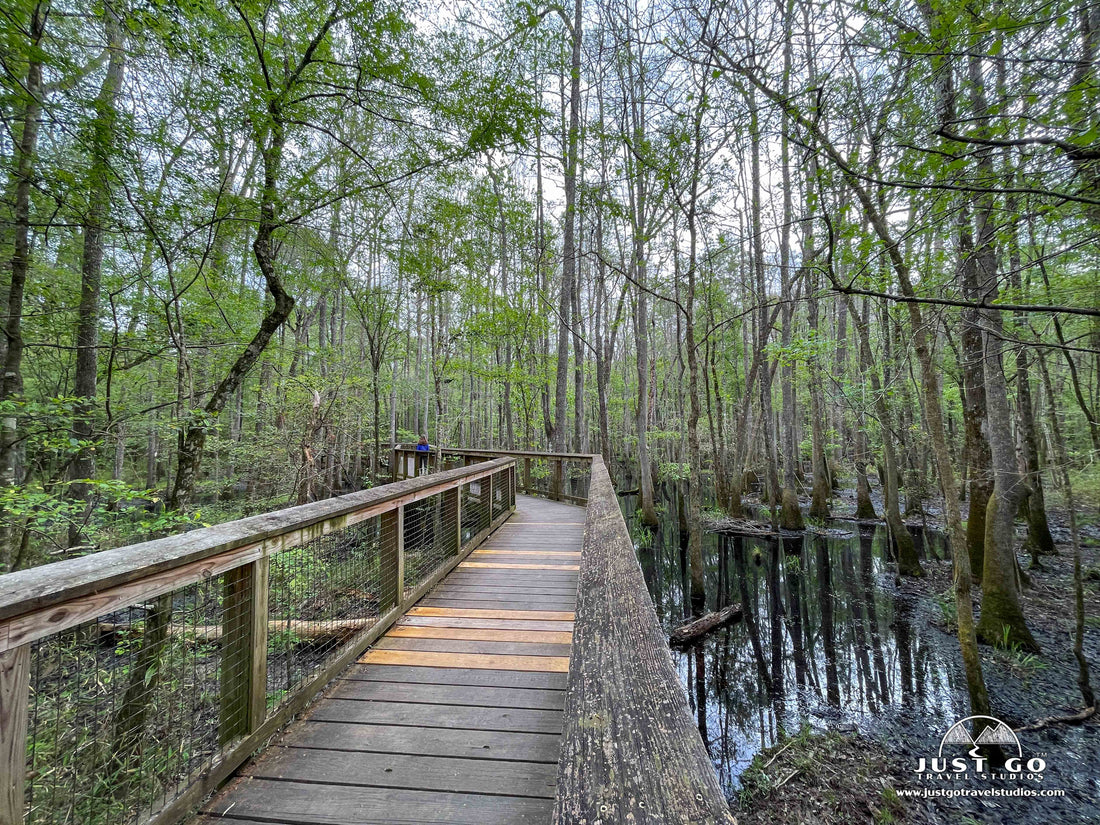Located in central South Carolina, Congaree National Park protects over 26,000 acres of the of old-growth bottomland hardwood forest--the largest remaining tract of its kind in North America. Compared to other national parks, it is quite small in acreage; however, Congaree is home to a unique and fascinating ecosystem that supports a wide variety of life, including some of the tallest trees in the eastern United States region. Due to this exceptional biodiversity, Congaree earned its designation as an International Biosphere Reserve and serves as a valuable laboratory for scientists and students from around the world.

Congaree National Park contains over 21,000 acres of federally designated wilderness, which visitors can explore on foot or by water. With miles of hiking and canoeing trails, there are plenty of ways for visitors to access the Congaree wilderness and experience the park’s natural wonders. Walk among towering trees, spot a southern fox squirrel or pileated woodpecker and learn about the history of the floodplain.
Since it is a small park, a half day is enough to hike or canoe at Congaree. If you plan to do both or venture further into the wilderness, we recommend allowing a full day (or two) to visit the park. We hope this guide will help as you plan your trip to Congaree National Park!
Don’t forget! Before you head out on your trip, get a copy of our Congaree National Park itinerary! We cover all you need to know about hiking in the park, what to see and do, how to spend 1 to 3 days and much more!
CONGAREE NATIONAL PARK HISTORY
The Congaree floodplain and uplands are rich in the history of the people who have interacted with the land for thousands of years. Early Native American inhabitants, European explorers, escaped slaves seeking refuge in the wilderness, loggers, and hunters--these are the people in the floodplain who shaped the landscape.
However, it was rapid industrialization after the Civil War and subsequent logging operations that dramatically changed the landscape. In the late 1890s, the Beidler family purchased 15,000 acres of floodplain for its trees. Over a period of about 20 years, loggers cut entire stands of massive old-growth cypress trees. Since getting trees out of the dense, wet forest was hard and costly, logging operations came to a halt but the danger to the forests was not yet over.
With hopes the land could be logged again in the future, the Beidlers held onto it and leased sections out to local hunt clubs to use for recreation. Harry Hampton, for whom the park’s visitor center is named, was an avid hunter and outdoorsman who spent much of his time exploring the area. Recognizing the importance of saving the forest he loved, Hampton worked tirelessly to preserve the Congaree River floodplain. By the late 1960s, logging again threatened the remaining giants of the Congaree bottomland forest.
Although Harry Hampton was unable to stop the destruction, his efforts inspired a new generation of advocates in the 1970s. In 1976, Congress established the Congaree Swamp National Monument. It was given International Biosphere Reserve status in 1983 and over two-thirds of the national monument was designated a wilderness area in 1988. Finally, in 2003, Congress redesignated the national monument as Congaree National Park, dropping the misleading “swamp” from the park’s name. [The national park is a floodplain, not a swamp. A swamp is permanently covered with water, while a floodplain (or bottomland) is a low-lying area near a river that floods on a seasonal basis.]

Despite its redesignation, Congaree is one of the least visited national parks in the United States, with just over 200,000 visitors per year. However, if you time your trip right (to avoid the heat, floods, and insects!), you are likely to enjoy a trip to an utterly unique landscape teeming with life.
FUN AND INTERESTING FACTS ABOUT CONGAREE NATIONAL PARK
- Congaree National Park, like the Congaree River, is named after the Congaree people who lived on the floodplain in the 17th and 18th centuries.
- Congaree is home to numerous champion trees, the largest living specimens of their species. No other area in North America has a larger concentration of champion trees! Congaree’s forest is also one of the tallest deciduous forests in the world, with trees averaging over 130 feet in height! The park’s tallest trees include loblolly pine, sweetgum, cherry bark oak, and American elm.
- The park’s magnificent bald cypress trees are equally impressive with circumferences up to 27 feet and extensive root systems. They can live over 1,000 years and their wood is rot and water resistant. One of the coolest features of bald cypress trees is their “knees,” roots that rise from the ground and can be seen throughout the forest floor. It is believed that the knees provide structural support during high winds and floods.
- Water tupelos, which dominate a large section of the Low Boardwalk, can be identified by their swollen trunks. They only grow where water is plentiful. Moss on the lower part of the tree indicates the water level from previous floods.
- It may just look like mud to most, but the ground itself is pretty amazing! As you walk along Congaree’s Boardwalk Trail, you will see Dorovan muck, a dark, muddy soil made of clay and decaying organic matter. It plays a significant role in the health of the floodplain—filtering water, trapping pollution, and turning pollutants into harmless compounds.
ACTIVITIES AT CONGAREE NATIONAL PARK

Congaree National Park map, courtesy of the National Park Service
To preserve the wilderness quality of the park, nearly all of Congaree’s infrastructure is confined to a small area in its northwestern end. The main entrance of the park provides access to the visitor center, two campgrounds, the boardwalk and hiking trails. The park is open 24 hours per day, year-round.
These are our recommendations for activities at Congaree National Park:
- Harry Hampton Visitor Center. Named for the man who fought to save the Congaree River floodplain, the Harry Hampton Visitor Center is a good place to begin your trip to Congaree National Park. You will find hiking information, exhibits about the park’s natural and cultural history, a park film, and a bookstore. The visitor center is open daily from 9 am to 5 pm except for President’s Day, Columbus Day, Thanksgiving, Christmas, and New Year’s Day.
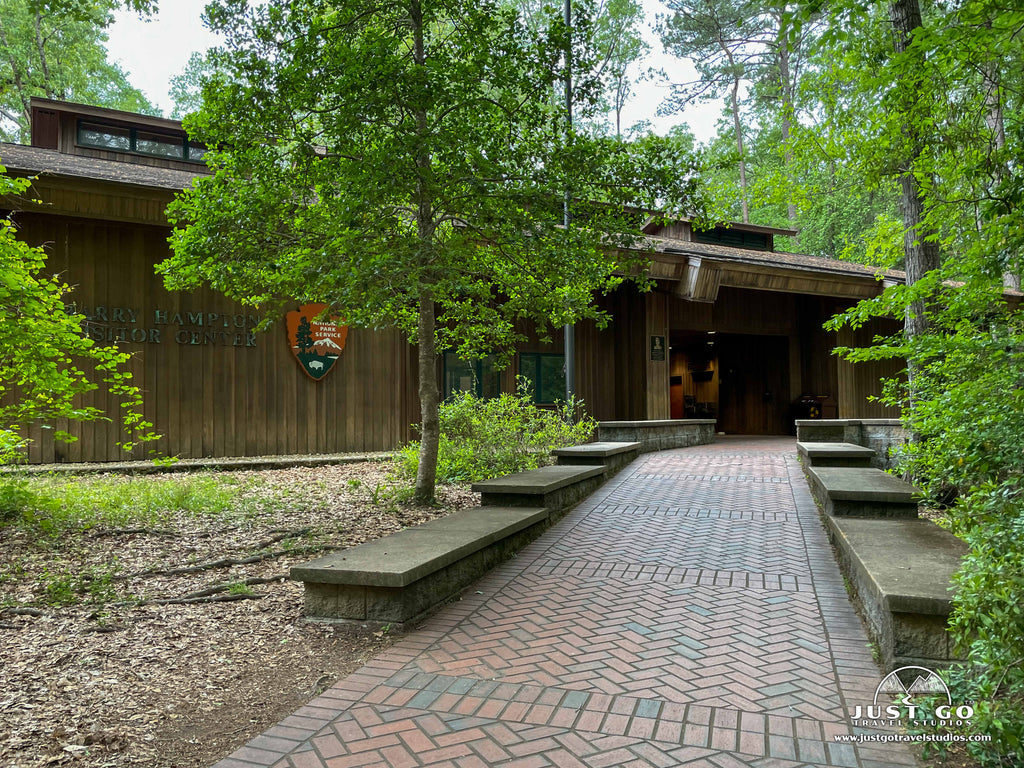
- Canoeing and Kayaking. Another great way to get up close and personal with Congaree’s wilderness is by paddling Cedar Creek. Paddle through the floodplain on the 15-mile Cedar Creek Canoe Trail. This marked waterway starts at Bannister’s Bridge and winds through the park to the Congaree River. A popular daytrip option for visitors with only one vehicle is to put in at South Cedar Creek Landing and paddle upstream for a portion before returning downstream to the same canoe launch. The water is slow moving, so it is easy to paddle in both directions. Visitors seeking a multi-day experience can paddle the 50-mile Congaree River Blue Trail, which extends from Columbia to Congaree National Park (a permit is required for overnight camping). Bring your own canoe or kayak, rent a canoe or kayak, or book a guided trip with a local kayak outfitter. See the NPS page for canoe trail information and to check the water level before heading to the park.
- Firefly Viewing (seasonal). Congaree National Park is home to synchronous fireflies, a rare species that creates an amazing light show at the park. For about two weeks every year (starting mid-May), Congaree visitors can witness a unique mating ritual where these fireflies synchronize their flashing. The synchronous firefly viewing event is extremely popular, so passes are required to enter the park on event nights and are awarded through a lottery system. If you plan to visit mid to late-May, be sure to enter the lottery, which typically opens early April!
- Fishing. With a valid South Carolina fishing license, fishing is allowed at Congaree National Park. See the NPS page for fishing regulations at Congaree National Park.
THE BEST HIKES IN CONGAREE NATIONAL PARK
One of the best ways to experience the wonders of Congaree’s wilderness is to go for a hike. The park has over twenty-five miles of hiking trails and 2.4 miles of boardwalks. Whether you are seeking a short stroll on the Boardwalk Trail or a longer trek into the park’s backcountry, there are hiking options for visitors of all abilities. The terrain is generally flat with little elevation change since most of the park lies within a floodplain. The majority of trails begin from the visitor center. All trails except for the Elevated Boardwalk, Bluff, Firefly and Longleaf may experience periodic flooding. Be sure to check current conditions for any trail closures.
We recommend the following hikes at Congaree National Park:
- Boardwalk Loop Trail. The Boardwalk Loop Trail is a great introduction to the park and an excellent choice if you only have time for one activity while visiting Congaree. This easy, 2.6-mile loop trail starts at the Harry Hampton Visitor Center and loops through old-growth bottomland hardwood forest. Wander among towering loblolly pines, bald cypress and tupelo trees! When the trail is dry, the boardwalk is wheelchair and stroller accessible. However, if it has been raining, parts of the Low Boardwalk may be slick or even underwater. The Elevated Boardwalk portion is accessible even when the water is high. Pick up a Self-Guided Boardwalk Tour brochure at the visitor center before beginning your walk to learn all about Congaree’s cultural and natural history. The Boardwalk Loop Trail begins behind the visitor center. Allow about an hour to walk the full loop. The Boardwalk Loop Trail also provides access to other trails that wind through the Congaree flood plain, including access to Weston Lake.
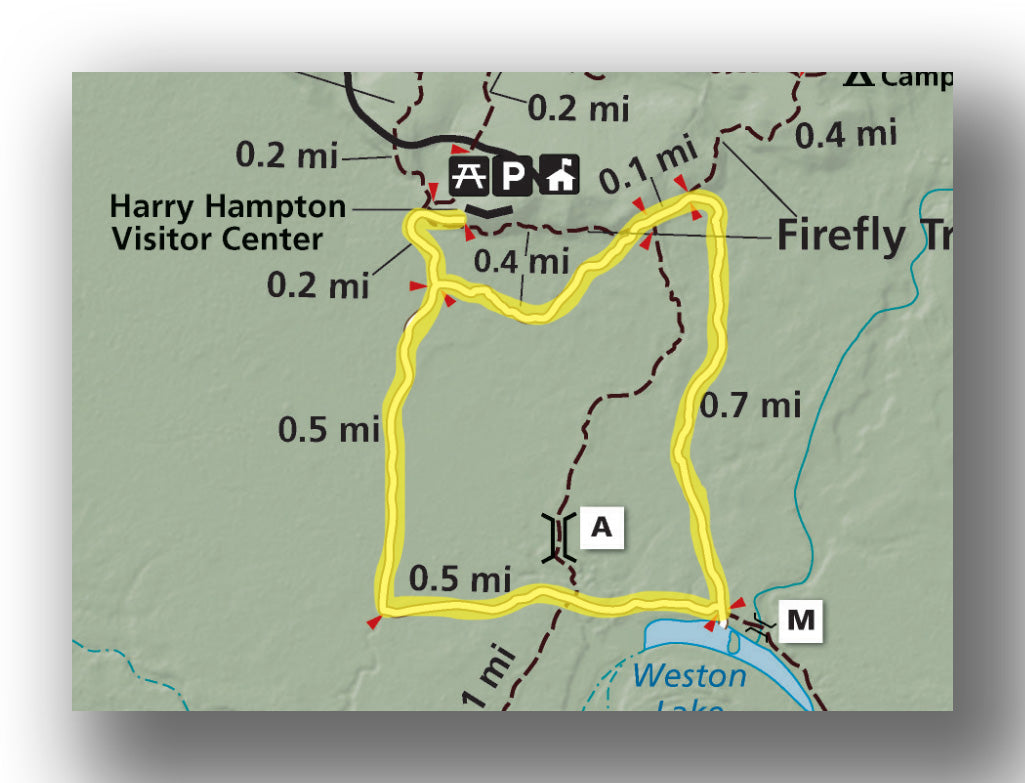


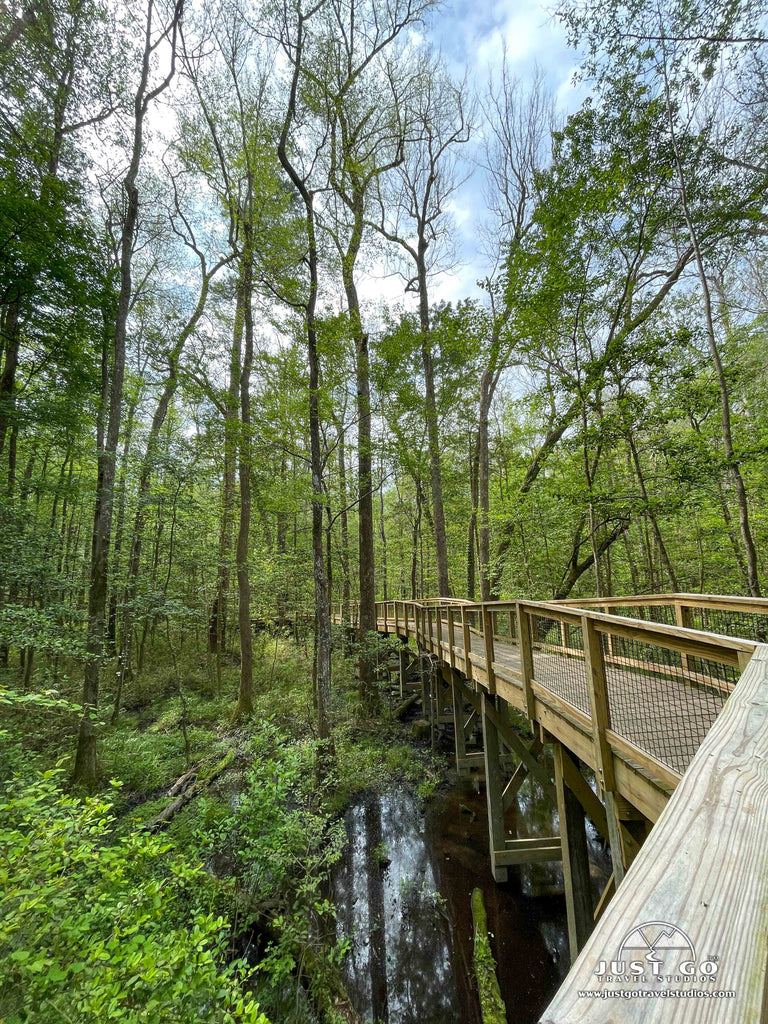
- Bluff Trail. The Bluff Trail is a gentle path through young, upland pine forest. The 1.8-mile trail loops north of the visitor center and connects to the Elevated Boardwalk for a short distance. Then, it passes through the upland’s new growth forest of loblolly and longleaf pines. The Bluff Trail begins from the visitor center. Allow about 30-45 minutes for this hike.
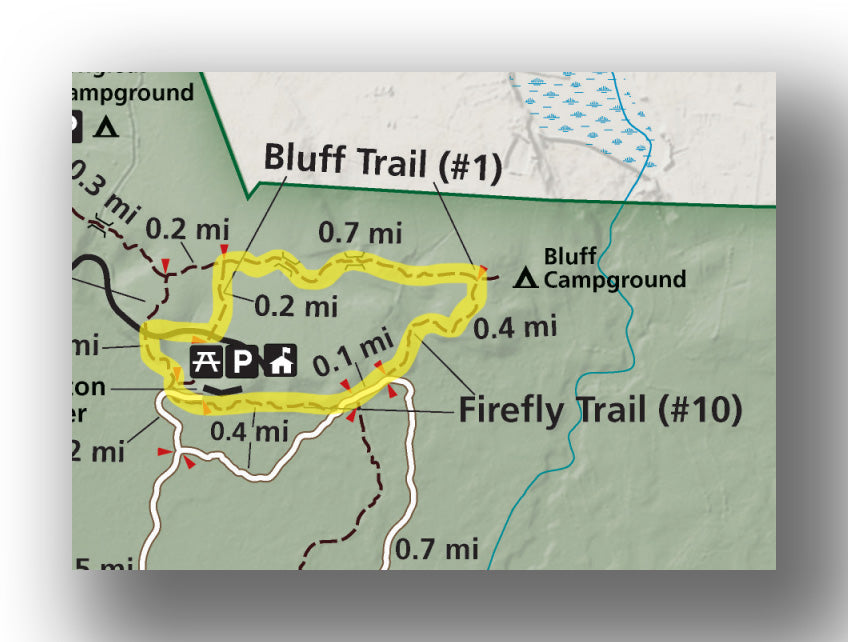
- Bates Ferry Trail. The Bates Ferry Trail is an easy, 2.2-mile roundtrip hike that follows a historic colonial road along Bates Old River. It offers the easiest access to the Congaree River in Congaree National Park. The Bates Ferry Trailhead is in the far eastern section of the park just off Highway 601. Allow 30-45 minutes for this hike.

- Weston Lake Loop Trail. Weston Lake was once a bend in the Congaree River and is now an oxbow lake. This 4.5-mile round-trip hike is a good option for those seeking a longer trek and the possibility of spotting wildlife. Look for great blue herons, osprey, otters, turtles, and other wildlife while exploring the Weston Lake Loop Trail. The hike starts from the Boardwalk Loop Trail (low section) and passes through old-growth cypress and tupelo forest. It then travels along the edges of Cedar Creek and Weston Lake before rejoining the Boardwalk Loop Trail (elevated section). The Weston Lake Loop Trail starts from the Boardwalk Loop Trail. Allow 1.5-2 hours for this hike. Backwoods trails like the Weston Lake Trail are maintained on a limited basis and can blocked by downed trees or flooded waterways. Be sure to check trail conditions before heading out on this hike.

See the NPS website for more information on hiking trails at Congaree National Park.
HOW TO GET TO CONGAREE NATIONAL PARK AND OTHER TRAVEL INFORMATION
Congaree National Park is in the heart of South Carolina. The nearest major airport is Columbia Metropolitan Airport, which is about a 30-minute drive from the park. Charlotte Douglass International Airport, located in Charlotte, North Carolina, is a larger airport with lots of flight options. It is about a 2-hour drive from the park.
- If flying into Columbia Metropolitan Airport, here are directions from Columbia to Congaree National Park. The 24-mile drive will take about 30 minutes.
- If flying into Charlotte Douglass International Airport, here are directions from Charlotte, NC to Congaree National Park. The 110-mile drive will take about 2 hours.
- Approximate travel distances/times if driving from other destinations in the southeast:
- Charleston, SC: 2 hours; 110 miles
- Asheville, NC: 3 hours; 180 miles
- Savannah, GA: 2.5 hours; 150 miles
There is limited parking for RVs, trailers, and oversized vehicles at Congaree National Park. Approximately half of the parking stalls in the third lot at the visitor center are designated for oversized vehicles, but these can fill quickly during busy times. RVs towing trailers may have to unhook to turn around in the visitor center parking lot on busy days.
ENTRANCE FEES FOR CONGAREE NATIONAL PARK
No fees--entrance to Congaree National Park is free! The main entrance to the park is on Old Bluff Road and provides access to the visitor center, campgrounds, and trails.
WHERE TO STAY IN CONGAREE NATIONAL PARK
Congaree National Park Lodging: There are no lodging options inside Congaree National Park. The closest accommodations are in Columbia, SC, 20-30 minutes from the park.
Congaree National Park Camping: Tent camping is the only way to spend the night inside the park. There are two designated campgrounds--Longleaf Campground and Bluff Campground. Neither can accommodate RVs or trailers. Campers must park and walk or hike to their campsite. Both are open year-round by reservation; however, securing a reservation is rarely an issue since the campgrounds are rarely crowded. For visitors headed into the backcountry for a wilderness adventure, a free backcountry camping permit is required.
Longleaf Campground:
- Location: Longleaf Campground is located just off the park entrance road and about a ½ mile before the visitor center.
- Accessible via: Campground parking area accessible by car/campsites by foot travel.
- Reservations: The campground is open year-round, by reservation only. Visit recreation.gov to make your reservation. Individual sites can be booked up to 6 months in advance and group sites can be booked up to a year in advance.
- Capacity: 10 individual sites (maximum of 8 individuals and 3 tents) and 4 group sites (minimum of 9 individuals and no more than 24, with a maximum of 10 tents per site). All sites are walk-up. Only tents and hammocks are allowed in the campground.
- Electricity / Water Hookups / Dump Station: No / No / No.
- Toilets / Showers: Vault toilets, no showers. No potable water in the campground but running water is available at the visitor center.
- Additional details: Firepit and picnic table. Pets are allowed at the campground but must always be leashed and never be left unattended.
Bluff Hike-In Campground:
- Location: Bluff Campground is located at the intersection of the Bluff and Firefly Trails about one mile from the visitor center and one mile from the Longleaf Campground.
- Accessible via: Foot travel. It is a hike-in only campground and cannot be accessed by vehicle.
- Reservations: The campground is open year-round, by reservation only. Visit recreation.gov to make your reservation. Sites can be booked up to 6 months in advance.
- Capacity: 6 sites (maximum of 8 individuals and 3 tents). All sites are hike-in.
- Electricity / Water Hookups / Dump Station: No / No / No.
- Toilets / Showers: No / No. Running water and flush toilets are available at the visitor center.
- Additional details: Firepit and picnic table. Pets are allowed at the campground but must always be leashed and never be left unattended.
WHEN IS THE BEST TIME TO VISIT CONGAREE NATIONAL PARK?
Due to its humid subtropical climate, Congaree National Park has mild winters and extremely hot and humid summers. Although the park is open year-round, the best times to visit Congaree are early spring and late fall when temperatures are comfortable for exploring and mosquito numbers are low.
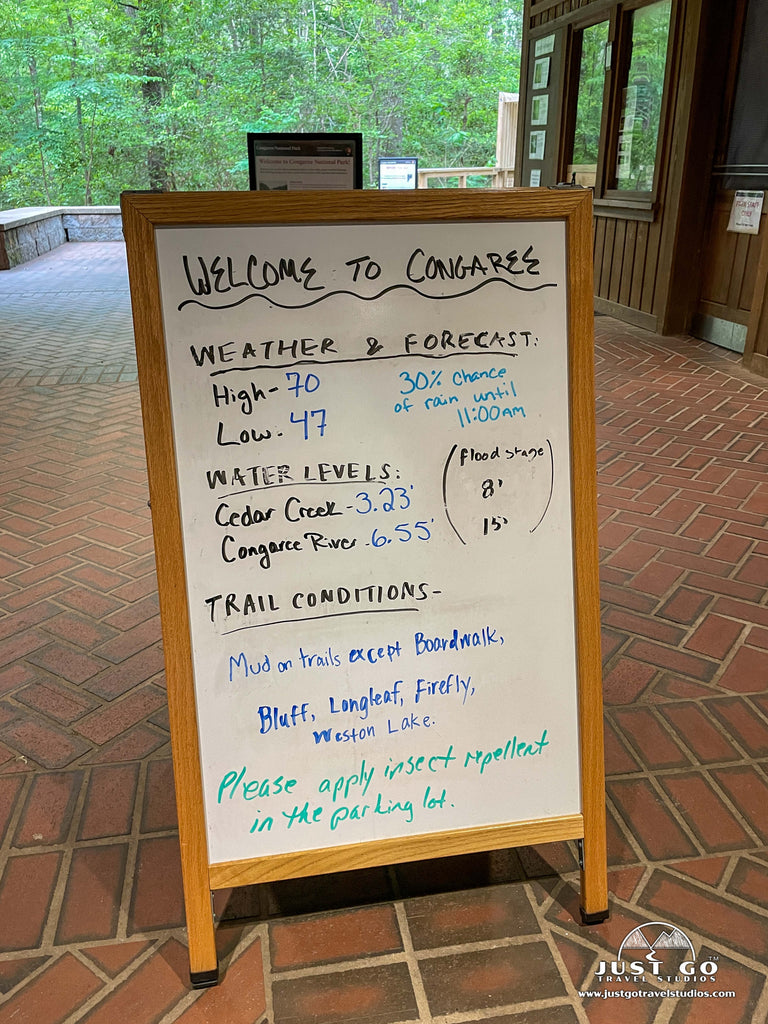
Spring is a popular time to visit Congaree. From March through May, temperatures are comfortable with average daily highs in the 70s. Insects are not typically bothersome until late spring. Average monthly precipitation is three inches.
Summer is the slowest season at the park. June through September is the hottest and most humid time of year at Congaree. Daily highs can reach into the upper 90s, and even up over 100 degrees. High humidity makes it feel even hotter, and thunderstorms can pop up with little to no warning. Average monthly rainfall is 4.5 inches. Mosquitoes are at their worst this time of year--War Zone level on the Mosquito Meter!
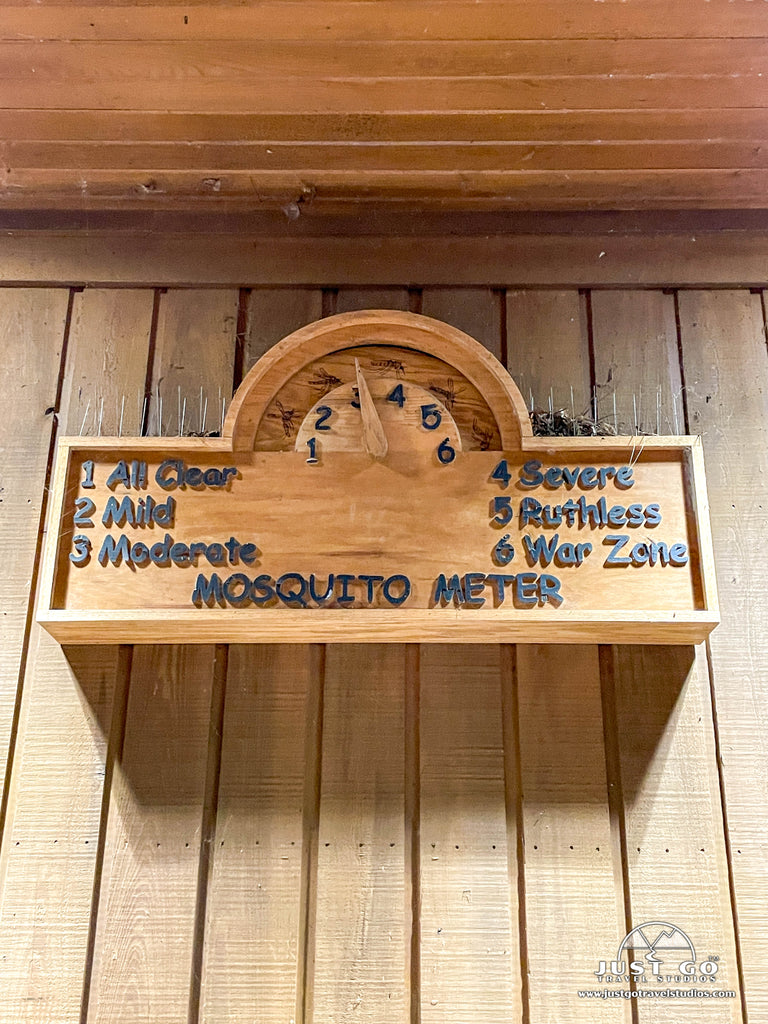 Fall is another great season to visit the park. From October through November, temperatures are pleasant with daily highs in the 60s and 70s and low humidity. Peak fall colors occur between late October and early November. Average monthly rainfall is about 3 inches. Water levels are ideal in the fall for a paddle trip on Cedar Creek.
Fall is another great season to visit the park. From October through November, temperatures are pleasant with daily highs in the 60s and 70s and low humidity. Peak fall colors occur between late October and early November. Average monthly rainfall is about 3 inches. Water levels are ideal in the fall for a paddle trip on Cedar Creek.
Winter brings mild to chilly temperatures at the park, and mosquitoes are not a problem. However, flooding is most common in the winter months. After heavy flooding, some trails in the park can temporarily close. Backcountry camping and paddling are not recommended during flood conditions. Before planning your trip, check current conditions at Congaree National Park.
WHAT TO BRING TO CONGAREE NATIONAL PARK
Bring everything you need to enjoy your time at Congaree National Park since there are no stores or restaurants in the park.
- Snacks/lunch and water. Bring a cooler with all the food and drinks you will need for the duration of your visit.
- Insect repellant. Mosquitos can be so bad that Congaree has a ‘Mosquito Meter’ by the entrance to the visitor center. Mosquitoes are at their worst from late spring through early fall, but it is best to bring bug spray year-round. We visited late April when the mosquitoes were at the moderate level, and we barely noticed them when we were moving (we did apply bug spray in the parking lot).
- Pack your sunscreen. Many of the park’s trails are forested but there are some areas with less tree coverage.

IS THERE CELLULAR SERVICE IN CONGAREE NATIONAL PARK?
Yes, public WiFi is available at the Harry Hampton Visitor Center at Congaree National Park. However, cell service is spotty throughout the rest of the park.
ARE PETS ALLOWED IN CONGAREE NATIONAL PARK?
Yes! Congaree National Park is one of only a few national parks that welcomes leashed pets. They are allowed on all trails and in the campgrounds. For your pet to have a safe and positive experience while visiting the park, they must be always on a leash (6-feet or less) and under your control. If your dog is uncomfortable with other people or pets, avoid elevated sections of the Boardwalk Trail. Do not leave pets unattended in your vehicle or on your campsite. Summer months are especially hot and humid, so make sure to carry water for your pet while out exploring the trails.
RELATED INFORMATION ON CONGAREE NATIONAL PARK FROM JUST GO TRAVEL STUDIOS
- Don’t forget to get a copy of our itinerary for Congaree National Park! We cover all you need to know about visiting the park in our digital guide.
- When you get back from your trip, send us a photo and we’ll create a custom, vintage travel poster using your own custom wording!


